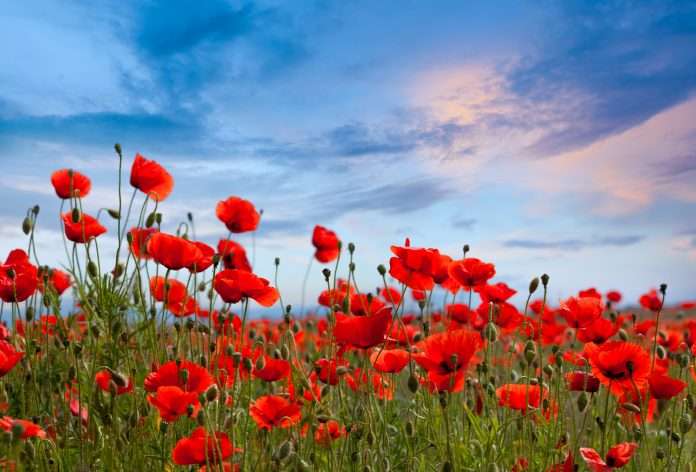We honor and remember our country’s veterans “on the eleventh hour of the eleventh day of the eleventh month.”
In Flanders fields the poppies blow
Between the crosses, row on row,
That mark our place; and in the sky
The larks, still bravely singing, fly
Scarce heard amid the guns below.
We are the Dead. Short days ago
We lived, felt dawn, saw sunset glow,
Loved and were loved, and now we lie
In Flanders fields.
Take up our quarrel with the foe:
To you from failing hands we throw
The torch; be yours to hold it high.
If ye break faith with us who die
We shall not sleep, though poppies grow
In Flanders fields.
By John McCrae, MD 1872 –1918
The poppy became the official flower of the American Legion family to memorialize the soldiers who fought and died during WWI. While National Poppy Day is recognized as the Friday before Memorial Day in May, poppies symbolize our respect of our nation’s military heroes. Veterans Day (formerly Armistice Day) came about to commemorate the fallen soldiers of World War I and continues as a holiday to honor not only soldiers who have died in service to America, but to commemorate the service of all U.S. veterans.
Why the poppy? After World War I, the poppy flourished in Europe. Scientists attributed the growth to soils becoming rich from the lime of the rubble left from the war. The beautiful red poppy that grew came to symbolize the blood shed during the battles visualized in the poem “In Flanders Fields.”
While the poppies of the poem are traditionally red, poppies come in many varieties and colors. The iconic wildflower of California is a bright yellow orange. Breadseed varieties (edible poppy seeds) range from pastels to purples, with the most common being a Peony Poppy which derives its name from the multi-petaled bloom similar to a peony.
Poppies are considered an annual flower grown from seed. Frequently, poppies will reseed from the previous year’s plants. The seeds are extremely small (100,000 seeds per ounce.). To plant, mix seeds with find sand and broadcast mixture directly onto soil. Do not cover as seeds need light to germinate. Seeds are best sown in late fall through early December. Germination occurs when exposed to freezing and thawing conditions. Poppy seeds go through a dormancy and require nearly four weeks to emerge. Fall sowing is essential because it takes plants nearly five months from sprout to mature plant. This dormancy can be artificially broken by placing seeds in a moist growing medium in a refrigerator for four to eight weeks prior to planting, depending upon variety. Seeds can then be planted in early spring. Once seeds are planted, it is mostly a waiting game until spring, but continue to remove cool-season weeds.
Because poppy seeds are so small, when they sprout, there are many seedlings. Thin seedlings to six to nine inches apart, to allow for air flow and lower susceptibility to pests and diseases. Be vigilant about weeding because seedlings do not do well in competition with weeds. While poppies will grow in poor soils, they do better in fertile soil, rich in lime with adequate water, especially during dry spells. Flowering begins in late spring to early summer. Poppies need at least six hours of sun to germinate and blossom. Seed pod maturation occurs mid-to late summer, about eighty to ninety days after planting.
There are many varieties of poppies. Some are to grow edible poppy seeds and others are prized for the blooms for cut flowers. A few of the edible varieties which can be grown in Oklahoma are the Peony Poppy, the Elka Poppy which originated in Slovakia, the Heirloom Pepperbox, and the Hungarian Blue Breadseed Poppy. The blooms on these poppies range from pale blue to purple and they produce a very large seed head after the bloom has dried.
For use as cut flowers, Red Poppies (papaver rhoeas), also called Flanders or field poppies are popular in Oklahoma. They have also been hybridized to create the Shirley Poppy. Shirley poppies have about a 3-foot stalk and grow well in flower beds. Shirley poppies range in colors from soft pastels to vibrant reds. Oriental poppies (papaver orientale) are perennial poppies. They can take a wide range for temperatures from -10 up to 90 degrees. These plants spread up to two feet wide, with blooms on 12-to-30-inch stalks up to four inches in diameter. Another local favorite for floral arranging are the Iceland poppies (papaver nudicaule)
Harvesting flowers frequently will encourage more blooms. Cut the stems near to the ground, just as the bloom begins to crack open. Remove all leaves from the stem. Sear the cut end with a match or place the end of the stem in hot water (110 to 180 degrees) for a half a minute to treat for the milky latex that is messy and prevents the flower from lasting without heat treatment.
Harvest seed pods as soon as the petals fall off the bloom during dry weather conditions, when the seeds begin to rattle inside the pod. Seed pods make a beautiful addition to dried flower arrangements. While harvested seeds maintain their flavor and quality for culinary purposes for quite some time, seed viability is quickly lost. Seeds intended for planting should not be stored for more than a year.
All parts of the poppy plant, except the seeds, are toxic and contain alkaloids used to manufacture opium. While it is legal to grow Papaver somniferum poppies in the United States for garden and seed production purposes, it is illegal to manufacture opium from the poppies. Pet owners should monitor their pets, although poppy plants are so distasteful that most pets avoid them after a sniff or brief taste. So, while the seeds may be edible, the beautiful color of the red poppy reminds us of our military veterans. As you remember our heroes this November, plant some seeds in anticipation of next spring.






